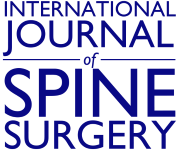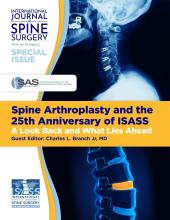ABSTRACT
Background Adult sagittal spinal deformity (SSD) leads to the recruitment of compensatory mechanisms to maintain standing balance. After regional spinal compensation is exhausted, lower extremity compensation is recruited. Knee flexion, ankle flexion, and sacrofemoral angle increase to drive pelvic shift posterior and increase pelvic tilt. We aim to describe 2 summary angles termed ankle-pelvic angle (APA) and global lower extremity angle (GLA) that incorporate all aspects of lower extremity and pelvic compensation in a comprehensive measurement that can simplify radiographic analysis.
Methods Full-body sagittal stereotactic radiographs were retrospectively collected and digitally analyzed. Spinal and lower extremity alignment were quantified with existing measures. Two angles—APA and GLA—were drawn as geometrically complementary angles to T1-pelvic angle (TPA) and global sagittal axis (GSA), respectively. Regression analysis was used to represent the predictive relationship between TPA and APA and between GSA and GLA.
Results A total of 518 propensity score-matched patient records were available for analysis. Patients with lower extremity compensation had higher APA (21.83° versus 19.47°, P = .007) and GLA (6.03° versus 1.19°, P < .001) than those without compensation. APA and GLA demonstrated strong correlation with TPA (r = 0.81) and GSA (r = 0.77), respectively. Furthermore, the change between preoperative and postoperative values were strongly correlative between ΔAPA and ΔTPA (r = 0.71) and between ΔGLA and ΔGSA (r = 0.77). APA above 20.6° and GLA above 3.6° were indicative of lower extremity compensation. Patients with increased GLA values had significantly higher Oswestry Disability Index scores (48.67 versus 41.04, P = .005).
Conclusions TPA and GSA are measures of global spinal alignment and APA and GLA, respectively, and are geometrically complementary angles that vary proportionately to SSD and balance the body. APA and GLA increase in SSD patients with lower extremity compensation and decrease with corrective surgery.
Level of Evidence 4.
Clinical Relevance APA and GLA offer a concise and simple method of communicating pelvic and lower extremity compensation.
Footnotes
Disclosures and COI: The manuscript submitted does not contain information about medical device(s)/drug(s). No funds were received in support of this work. Dr Buckland reports personal fees from Stryker and Nuvasive outside the submitted work. Dr Errico reports personal fees from K2M, grants from Pfizer and ISSGF, and other from Fastenetix and Harms Study Group outside the submitted work. Dr Protopsaltis reports personal fees from Medicrea, NuVasive, Innovasis, and K2M; grants from Cervical Spine Research Society and Zimmer Biomet; and other from Torus Medical and Globus Medical outside the submitted work. Dr Vaynrub and Dr Tishelman have nothing to disclose. The authors report no conflict of interest concerning the materials or methods used in this study or the findings specified in this paper.
- This manuscript is generously published free of charge by ISASS, the International Society for the Advancement of Spine Surgery. Copyright © 2021 ISASS







